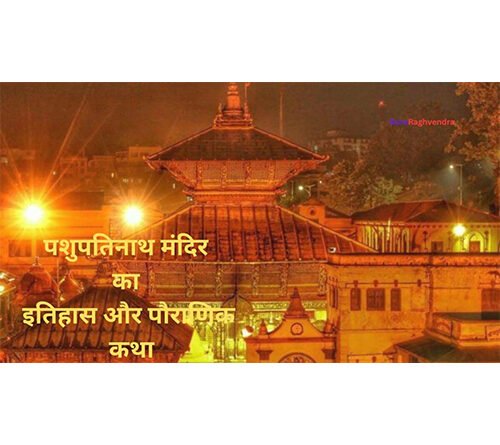History and mythology of Pashupatinath temple!
In our old post, we told you all about Narmadeshwar Shivling, Nageshwar-Shivling, Kashi Vishwanath, Omkareshwar Jyotirling, Rameshwaram Temple and Mahakaleshwar Temple, moving ahead in this sequence, today we will tell you about the history and mythology of Pashupatinath Temple. Through Pashupatinath Nepal, we will know about Pashupatinath Temple – which is a Sanatani temple dedicated to Mahadev Shiva. This is a Shiva temple dedicated to Shiva located in Devpatan village on the banks of Bagmati River, 3 km north-west of Nepal’s capital Kathmandu.
Before Nepal became a secular nation, this temple was considered to be the main residence of Lord Pashupatinath. This temple is included in the list of UNESCO World Cultural Heritage Site. Hindus who have faith in Pashupatinath temple are allowed to enter the temple premises. Non-Hindu visitors are allowed to view it from outside, from the other bank of the Bagmati River.
History and mythology of Pashupatinath temple…
Pashupatinath Napal: This temple is considered to be the most sacred temple of Shiva in Nepal. There is a tradition started from the 15th century king “Pratap Malla” that the temple has four priests (Bhatt) and one main priest (Mul-Bhatt) Brahmins of South India. Which are kept continuously till today. The festival of Shivratri is especially celebrated in Pashupatinath temple.According to legends, this temple was built by Pashu-Praksha of “Somdev Dynasty” in the 3rd century AD. It was done in the past but the available historical documents are from the 13th century only. Other temples similar to this temple were also built in Bhaktapur 1480, Lalitpur 1566 and Banaras (early 19th century). The original temple was destroyed several times and was rebuilt by “Raja Naresh Bhupatendra Malla” in 1697.
1. Story of Pashupatinath Temple :-
According to the local story based on Nepal Mahatmya and Himavatkhand – Lord Shiva once left the other deities of Varanasi and went to the desert situated on the banks of Bagmati River, which is in the forest on the other bank of Bagmati River. Lord Shiva took the form of a gazelle and slept there. When the gods discovered him and tried to bring him back to Varanasi, he jumped to the other bank of the river.
During this, his horn broke into four pieces, after which Lord Pashupati appeared in the form of Chaturmukh Linga. Pashupatinath Temple of Nepal is in some ways considered to be the most prominent among all the temples. Meaning of ‘Pashupati’ – Pashu means ‘life’ and Pati means ‘master’ or owner i.e. ‘owner of life’ or ‘god of life’ Pashupatinath is actually a linga with four faces.
The face facing east is called “Tatpurush” and the face facing west is called “Sadjyot”, the face facing north is called “Vamveda” and the face facing south is called “Aghora”. These four faces are the four basic principles of Tantra Vidya. Some people also believe that the basic principles of the four Vedas also originate from here. It is believed that this Linga was established even before the Vedas were written and many mythological stories are related to it. are also connected. One of these stories is like this-
2. Mythology of Pashupatinath Temple :-
In the Mahabharata, after the battle of Kurukshetra, the Pandavas were extremely unhappy because of the killing of their own “brothers, the Kauravas”. They had killed their own brothers and relatives, this is called “Gotravadh”. He regretted his actions and felt guilty, so to free himself from this guilt, he set out in search of Shiva.According to the story of the famous Kedarnath temple located in the state of Uttarakhand in India, at the time of their departure to heaven, the Pandavas had seen Shiva in the form of a buffalo, who later disappeared into the earth, but Bhima had caught hold of his tail, hence his form was established at that place. Was called “Kedarnath” and the place where his face appeared outside the earth was called “Pashupatinath”-
FAQ-
1. What is not allowed in Pashupatinath temple?
Apart from Sanatani, entry of non-Sanatani people is prohibited in Pashupatinath temple. Along with this, taking photographs of Pashupatinath and the original temple is prohibited on the occasion of Hari Table Teej festival in the temple premises. Cameras are not allowed in the temple.
2. Which is the best day to visit Pashupatinath Temple?
Pashupatinath temple is dedicated to Lord Shiva. The best time to visit this temple is on the day of Mahashivratri. On this day, Shiva festival is celebrated with great pomp in the temple, during this time devotees come from all over Nepal and also from India to worship Shiva. . This temple is located in the heart of Kathmandu, about 3 km from the city centre.
3. How many faces are there in Pashupatinath temple?
Pashupatinath is a temple dedicated to Lord Shiva. Lord Shankar has five faces which represent different incarnations – 1. Sadyojata (Varun) 2. Vamdev (Uma Maheshwar) 3. Tatpurusha 4. Aghor and 5. Ishaan. represent.
4. Pashupatinath is the temple of which god?
Pashupatinath Temple is a temple dedicated to Lord Shiva. This artistic sculpture is carved out of fiery rock block of shining dark copper. The temples are situated on the banks of river Shivana.
5. What is the relationship between Kedarnath and Pashupatinath?
Kedarnath and Pashupatinath are two parts of the same Shivling. When the Pandavas had to meet Lord Shiva, Shiva took the form of a buffalo but before he could completely sink into the earth, Bhima caught hold of his tail, at the place where Bhima did this. The form of God was established at this place, which was later called Kedarnath Dham, whereas the place where the mouth of this buffalo came out of the earth was called Pashupatinath.
6. How old is Pashupatinath Temple?
The grand construction of Pashupatinath temple took place in the third century BC. It was built by King Pashupreksha of Somdev dynasty. There are some interesting historical beliefs related to the construction of this temple. If we believe them, then the temple was built in the 13th century. There is a temple of Pashupatinath in Kathmandu city of Nepal, which is also the center of unshakable faith of crores of Sanatani Hindus.
7. Which Shaktipeeth is near Pashupatinath?
Shaktipeeth located near Pashupatinath Temple in Nepal 1. Gujayeshwari Temple (Both knees of Maa Sati fell) Here Maa is worshiped by the name Mahashira. 2. Muktinath Temple (Maa Sati’s head fell) Here Mother is worshiped in the name of Gandaki Chandi. These Shaktipeeths are located on the banks of Gandaki River in Pokhara, Nepal. In this way, two Shaktipeeths are located near Pashupatinath.
8. How to visit Pashupatinath?
As you all know that Pashupatinath temple is a Shiva temple situated on the banks of Bagmati river. You should fix the time of 6 pm to visit the temple, you will definitely get to see this joyful evening aarti, this evening aarti of Lord Pashupatinath ji is very spectacular and the scene of cremation taking place on the banks of Bagmati river will be the best experience of your life. Can force you to think about.










